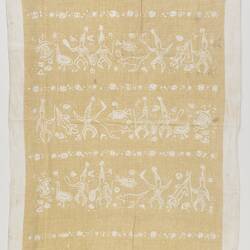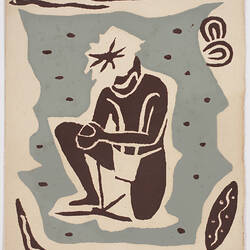Summary
Note: This object includes elements appropriated from First Peoples culture and heritage and stereotypical depictions. Such cultural appropriation and stereotyping is not condoned by Museums Victoria which considers it to be inappropriate, even racist. Historical distance and context do not excuse or erase this fact.
Alternative Name(s): Teatowel
Tea towel printed in dark blue on off-white background with pattern of stylised human and animal forms (the pattern is the same as that used for HT 24699). The images appropriate First Peoples artforms and the item was produced by John Rodriquez for commercial sale. The headdress depicted resembles that of a First Peoples' ceremonial headdress made from bark, human hair and feathers of the Kunana/Gununa (Mornington Island, Queensland) whose Traditional Owners are the Lardil People or Kunhanaamendaa (the people of Kunhanhaa).
John Rodriquez studied art and design at RMIT in the late 1940s and became well known for his screen-printed textile designs in the early 1950s. From 1950 to 1980 he was one of a handful of non First Peoples textile designers in Australia who developed a new contemporary style with innovative use of colour. His designs in the early 1950s were mostly geometric in style or utilised First Peoples (Australia) cultural heritage. He would typically issue a design in three or four colour combinations, and see which sold best. Later he turned to more abstract designs in the Scandinavian style. Later still he made bold use of colour. Rodriquez introduced unique Australian styles which have been imitated often since. He always stressed the importance of innovation. Many homes in Australia and overseas still have his art works in the linen cupboard.
John Rodriquez retired in 1988, handing the Rodriquez company to his son Rimian, who has computerised the screen printing and mostly employs other designers for the products, but still uses a few of his father's most popular designs. Rodriquez passed away in 2000.
Physical Description
Tea towel printed in dark blue on off-white background with pattern of stylized human forms with tall headdresses, variously carrying spears, shields and boomerangs, surrounded by animals - kangaroo, fish, emu and turtles. White on sand.
Significance
See Narrative 'John Rodriquez Textile Collection'.
The use of First Peoples' cultural heritage, as well as Australian native flora and fauna, became fashionable during the 1940s and 1950s. These motifs expressed a growing sense of Australian identity while the nation was experiencing the social upheavals of war and mass migration. Many migrant artists also began to adopt these motifs as they settled into their new country.The use of First Peoples' imagery in popular culture reveals a desire to reference local cultural heritage and landscape, to appropriate it for symbols of national identity, while simultaneously misunderstanding it, and setting First Peoples culture as being in the past and decorative, rather than complex, diverse, living and contemporary. Much of the First Peoples' imagery was commercialised and exploited without consent or compensation, a practice not in the sights of most commercial artists of the time.
More Information
-
Collection Names
-
Collecting Areas
-
Acquisition Information
Donation from Ms Patricia Rodriquez, 24 Jan 2006
-
Artist
-
Place & Date Made
-
Classification
-
Category
-
Discipline
-
Type of item
-
Overall Dimensions
500 mm (Width), 700 mm (Height)
-
References
Photocopies of old issues of Home Beautiful which display John's fabric designs have been offered by the donor. Newspaper cuttings showing clothes made from Rodriquez-designed fabrics.
-
Keywords
Aboriginal Art, Fabric Designs, Handcrafts, Screen Printing, Textile Manufacturing, Textiles, Innovation & Design



